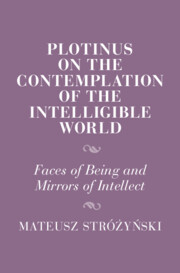Book contents
- Plotinus on the Contemplation of the Intelligible World
- Cambridge Studies in Religion and Platonism
- Plotinus on the Contemplation of the Intelligible World
- Copyright page
- Dedication
- Epigraph
- Contents
- Acknowledgements
- Introduction
- Part I Descent and Fall
- 1 So Many Mirrors
- 2 Out of the Father’s House
- Part II Soul
- Part III Intellect
- Conclusion
- Bibliography
- Index
2 - Out of the Father’s House
from Part I - Descent and Fall
Published online by Cambridge University Press: aN Invalid Date NaN
- Plotinus on the Contemplation of the Intelligible World
- Cambridge Studies in Religion and Platonism
- Plotinus on the Contemplation of the Intelligible World
- Copyright page
- Dedication
- Epigraph
- Contents
- Acknowledgements
- Introduction
- Part I Descent and Fall
- 1 So Many Mirrors
- 2 Out of the Father’s House
- Part II Soul
- Part III Intellect
- Conclusion
- Bibliography
- Index
Summary
This chapter discusses the fall of the soul as the process in which a microcosmic being cuts himself off from the macrocosmic realms by self-limiting excessive emphasis on the potential elements of his own being: the indefinite “I”, the movement of loving and the difference of knowing. The result of the fall is our exclusive identification with our body, but the body is not necessarily either the cause of it or the embodiment is the result of the fall. In light of the third, triadic principle of selfhood, the fall is described by Plotinus in three ways, as (1) the limitation and fragmentation of the self, (2) the quasi-spatial externalisation of what is known, and (3) the temporalisation of what is loved. The fall of the self results in the sense of the deadness of reality and the reducing of ourselves to a thing among things. The fall of knowing results in seeing everything as external to the seer, while the fall of loving results in feeling that what we desire is not here, but has to be pursued in the future (or is lost forever in the past).
Keywords
- Type
- Chapter
- Information
- Plotinus on the Contemplation of the Intelligible WorldFaces of Being and Mirrors of Intellect, pp. 56 - 88Publisher: Cambridge University PressPrint publication year: 2024



